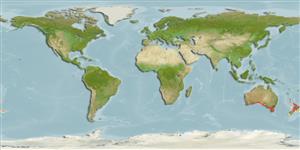>
Gadiformes (Cods) >
Gaidropsaridae (Rocklings)
Etymology: Gaidropsarus: Greek, ga, ge = the earth + Greek, ydro = water + Greek psaros = speckled, starling (Ref. 45335).
Environment: milieu / climate zone / depth range / distribution range
Ökologie
seewasser demersal; standorttreu; tiefenbereich 0 - 500 m (Ref. 9003). Temperate
Southwest Pacific: Tasmania and New Zealand.
Size / Gewicht / Alter
Maturity: Lm ? range ? - ? cm
Max length : 24.5 cm SL Männchen/unbestimmt; (Ref. 9985); common length : 15.0 cm TL Männchen/unbestimmt; (Ref. 30464)
Kurzbeschreibung
Bestimmungsschlüssel | Morphologie | Morphometrie
Rückenflossenstacheln (insgesamt) : 0; Rückenflossenweichstrahlen (insgesamt) : 56 - 70; Afterflossenstacheln: 0; Afterflossenweichstrahlen: 50 - 59; Wirbelzahl: 46 - 49. First dorsal reduced to a single ray followed by a band of brush-like filaments; second dorsal with 55-69 soft rays; gill rakers rudimentary (Ref. 9003). Caudal fin rounded. Dark brownish grey to reddish brown, paler below, sometimes with yellowish tinge (Ref. 9003).
Inhabits rock pools and shallow coastal waters; secretive species (Ref. 30464). Feeds on small invertebrates and fish (Ref. 9003). Probably nocturnal (Ref. 9003).
Life cycle and mating behavior
Maturities | Fortpflanzung | Spawnings | Egg(s) | Fecundities | Larven
Svetovidov, A.N., 1986. Review of the three-bearded rocklings of the genus Gaidropsaurus Rafinesque, 1810 (Gadidae) with description of a new species. J. Ichthyol. 26(1)114-135. (Ref. 9985)
IUCN Rote Liste Status (Ref. 130435)
Bedrohung für Menschen
Harmless
Nutzung durch Menschen
Fischereien: kommerziell
Tools
Zusatzinformationen
Download XML
Internet Quellen
Estimates based on models
Preferred temperature (Ref.
123201): 13.2 - 16.6, mean 14.5 °C (based on 77 cells).
Phylogenetic diversity index (Ref.
82804): PD
50 = 0.5001 [Uniqueness, from 0.5 = low to 2.0 = high].
Bayesian length-weight: a=0.00479 (0.00208 - 0.01103), b=3.08 (2.89 - 3.27), in cm total length, based on LWR estimates for this (Sub)family-body shape (Ref.
93245).
Trophic level (Ref.
69278): 3.9 ±0.57 se; based on food items.
Widerstandsfähigkeit (Ref.
120179): hoch, Verdopplung der Population dauert weniger als 15 Monate. (Preliminary K or Fecundity.).
Fishing Vulnerability (Ref.
59153): Low vulnerability (20 of 100).
